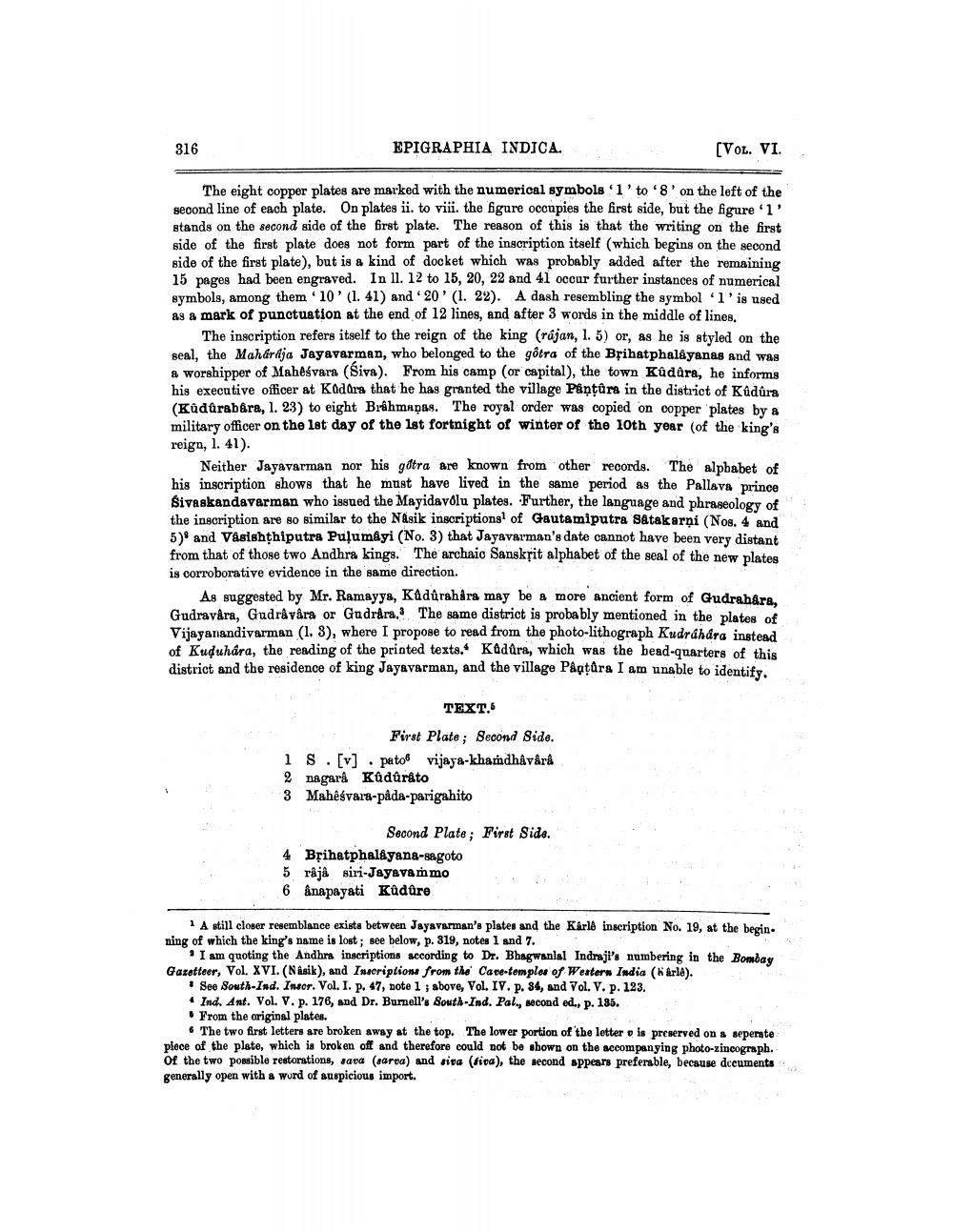________________
316
EPIGRAPHIA INDICA.
(VOL. VI.
The eight copper plates are marked with the numerical symbols '1' to '8' on the left of the second line of each plate. On plates ii. to viii. the figure occupies the first side, but the figure 1' stands on the second side of the first plate. The reason of this is that the writing on the first side of the first plate does not form part of the inscription itself (which begins on the second side of the first plate), but is a kind of docket which was probably added after the remaining 15 pages had been engraved. In 11. 12 to 15, 20, 22 and 41 occur further instances of numerical symbols, among them 10' (1. 41) and 20' (1. 22). A dash resembling the symbol 'l' is used as a mark of punctuation at the end of 12 lines, and after 3 words in the middle of lines.
The inscription refers itself to the reign of the king (rájan, 1.5) or, as he is styled on the seal, the Maharaja Jayavarman, who belonged to the gôtra of the Bțihatphalâyanas and was & worshipper of Mahesvarn (Siva). From his camp (or capital), the town Kudara, he informs his executive officer at Kodora that he has granted the village Pantura in the district of Kudura (Kûdûrabera, 1. 23) to eight Brahmanas. The royal order was copied on copper plates by a military officer on the lst day of the 1st fortnight of winter of the 10th year of the king's reign, 1. 41).
Neither Jayavarman nor his gótra are known from other records. The alphabet of his inscription shows that he must have lived in the same period as the Pallava prince Sivaskandavarman who issued the Mayidavólu plates. Further, the language and phraseology of the inscription are so similar to the Nasik inscriptions of Gautamiputra Satakarņi (Nos. 4 and 5) and Våsishthiputra Puļumayi (No. 3) that Jayavarman's date cannot have been very distant from that of those two Andhra kings. The archaic Sanskțit alphabet of the seal of the new plates is corroborative evidence in the same direction.
As guggested by Mr. Ramayye, Kadůrahara may be a more ancient form of Gudrah&ra. Gudravåra, Gudråyåra or Gudrara. The same district is probably mentioned in the plates of Vijayanandivarman (1. 3), where I propose to read from the photo-lithograph Kudráhdra instead of Kuduhara, the reading of the printed texts. Kadura, which was the bead-quarters of this district and the residence of king Jayavarman, and the village På tåra I am unable to identify
TEXT.
First Plate ; Second Side. 1 8 . [v] . pato vijaya-khandhåvåra 2 nagara Kudurato 3 Mahêsvara-pada-parigahito
Second Plate; First Side 4 Bțihatphalâyang-sagoto 5 râja Bii-Jayavammo 6 Anapayati Kudure
A still closer resemblance exists between Jayavarman's plates and the Kárld inscription No. 19, at the begin. ning of which the king's name is lost; see below, p. 319, notes 1 and 7.
I am quoting the Andhrs inscriptions according to Dr. Bhagwanlal Indraji's numbering in the Bombas Gazetteer, Vol. XVI. (Násik), and Inscriptions from the Care-temples of Western India (6&rle).
* See South-Ind. Insor. Vol. I. p. 47, note 1 ; above, Vol. IV. P. 84, and Vol. V. p. 123.
lod. Ant. Vol. V. p. 176, and Dr. Burnell's South Ind. Pal., second ed., p. 185. . From the original plates.
6 The two first letters are broken away at the top. The lower portion of the letter is preserved on & seperate piece of the plate, which is broken off and therefore could not be shown on the accompanying photo-zincograph. of the two possible restorations, sava (narea) and siva (fica), the second appears preferable, because documents generally open with a word of suspicious import.




